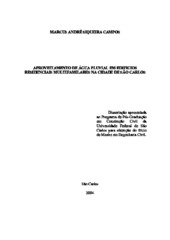| dc.contributor.author | Campos, Marcus André Siqueira | |
| dc.date.accessioned | 2016-06-02T20:09:10Z | |
| dc.date.available | 2006-06-12 | |
| dc.date.available | 2016-06-02T20:09:10Z | |
| dc.date.issued | 2004-05-06 | |
| dc.identifier.citation | CAMPOS, Marcus André Siqueira. Rainwater harvesting in a residential tall building in the city of São Carlos.. 2004. 145 f. Dissertação (Mestrado em Ciências Exatas e da Terra) - Universidade Federal de São Carlos, São Carlos, 2004. | por |
| dc.identifier.uri | https://repositorio.ufscar.br/handle/ufscar/4636 | |
| dc.description.abstract | The potable water scarcity afflicts the begging of the 21st Century, being today, one of the
main worries of the manhood. This way, it becomes necessary to reduce the per capita
consumption.
From the actions that promote the racional use of water, the technological ones seems to be ,
in the most of the cases, the most recomended to reduce the consumption without being necessary
radical changes of the users. One of these technologies is the rainwater harvesting. This one erges as
an action of good perspectives since it subistitutes the use of potable water in activities where it is
not necessary a good quality water, younder, it will reduce the amount of stormwater in the public
drainage net, working as a non-structural action of urban drainage.
The lack of kwondlege as well a the real advantages that a rainwater system can bring to a
builind, is the points to find out about this issue.. At this paper, it seeked to clear this techonolgy up
with the study of national and international examples .
It also seeked the cistern sizing, getting the best results to technical and economical issues,
as well, as procedures to design and to mantain the devices that make part of the system used in this
study.
Besides that, it studied the changes that would be necessary to build the system, and the
possibles changes at the work routine of the construction company. It also studied the financial
feasibility of the investiment of this interprisement, checking the real economical advantages that
can be get.
It is waited that this research contributes to the development of this techonology, contributing
to Racional use of water in residential tall buildings. | eng |
| dc.description.sponsorship | Financiadora de Estudos e Projetos | |
| dc.format | application/pdf | por |
| dc.language | por | por |
| dc.publisher | Universidade Federal de São Carlos | por |
| dc.rights | Acesso Aberto | por |
| dc.subject | Instalações hidráulicas e sanitárias | por |
| dc.subject | Uso racional de água | por |
| dc.subject | Aproveitamento de água pluvial | por |
| dc.subject | Sistemas prediais | por |
| dc.subject | Águas pluviais | por |
| dc.subject | Racional use of water | eng |
| dc.subject | Rainwater harvesting | eng |
| dc.subject | Rainwater plumbing system | eng |
| dc.subject | Plumbing systems | eng |
| dc.title | Aproveitamento de água pluvial em edifícios residenciais multifamiliares na cidade de São Carlos. | por |
| dc.title.alternative | Rainwater harvesting in a residential tall building in the city of São Carlos. | eng |
| dc.type | Dissertação | por |
| dc.contributor.advisor1 | Amorim, Simar Vieira de | |
| dc.contributor.advisor1Lattes | http://genos.cnpq.br:12010/dwlattes/owa/prc_imp_cv_int?f_cod=K4793215J8 | por |
| dc.description.resumo | A escassez de água potável atormenta o início do Século XXI, sendo hoje uma das principais
preocupações da humanidade neste século que começa. Dessa forma, surge a necessidade de
redução do consumo per capita.
Dentre as ações que promovem o uso racional da água, as tecnológicas parecem ser , na maioria dos
casos, as mais recomendadas para reduzir o consumo sem que seja necessário mudanças radicais
nos hábitos dos usuários. Entre estas, o aproveitamento de água pluvial surge como uma ação de
boas perspectivas, pois substitui o uso de água potável onde a qualidade desta não é necessária e, a
retirada desta diminuirá a quantidade de volume de água pluvial lançada na rede pública de
drenagem, funcionando como uma medida não-estrutural de drenagem urbana.
A falta de conhecimento técnico bem como das reais vantagens que um sistema de aproveitamento
de água pluvial poderá trazer para uma edificação são as principais incógnitas desse assunto. Neste
trabalho buscou-se clarear a tecnologia, com o estudo de diversos casos nacionais e internacionais.
Também se buscou realizar o dimensionamento de forma mais correta e econômica, bem como
listar procedimentos para elaboração e manutenção de todos os elementos constituintes do sistema
utilizado no edifício objeto de estudo.
Além disto, verificou-se as possíveis interferências nos processos construtivos, além de alterações
das rotinas de trabalho da construtora, além do estudo da viabilidade financeira do empreendimento,
verificando as reais vantagens da implantação do sistema neste caso.
Espera-se que esse trabalho contribua para o desenvolvimento de uma tecnologia específica para o
uso racional de água. | por |
| dc.publisher.country | BR | por |
| dc.publisher.initials | UFSCar | por |
| dc.publisher.program | Programa de Pós-Graduação em Engenharia Civil - PPGECiv | por |
| dc.subject.cnpq | ENGENHARIAS::ENGENHARIA CIVIL::CONSTRUCAO CIVIL | por |
| dc.contributor.authorlattes | http://genos.cnpq.br:12010/dwlattes/owa/prc_imp_cv_int?f_cod=K4775503A3 | por |
